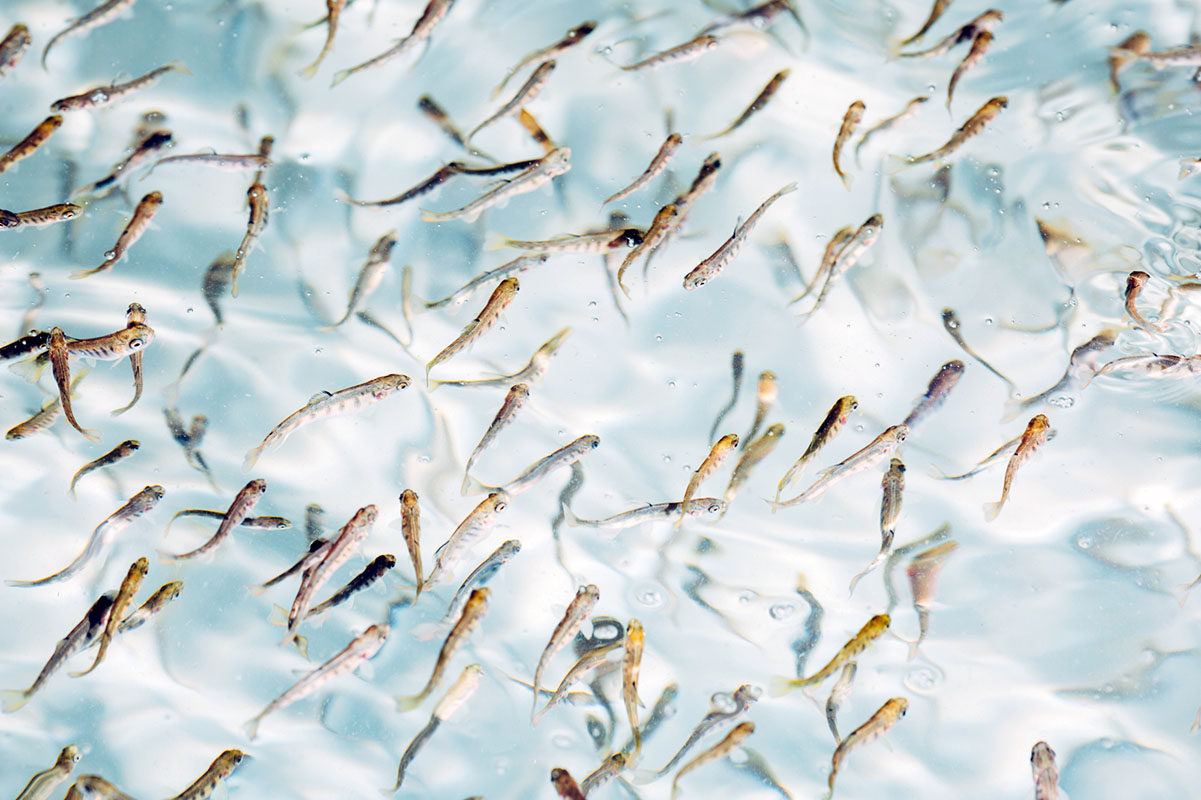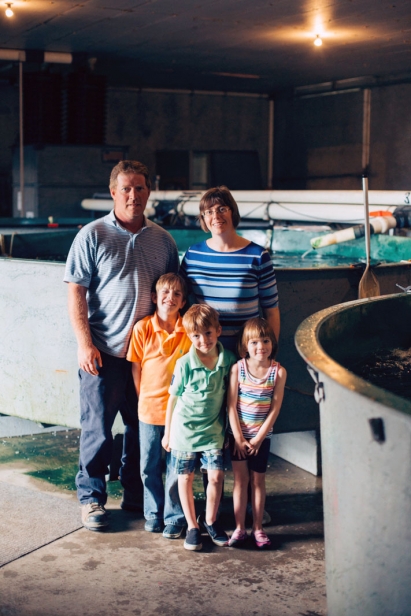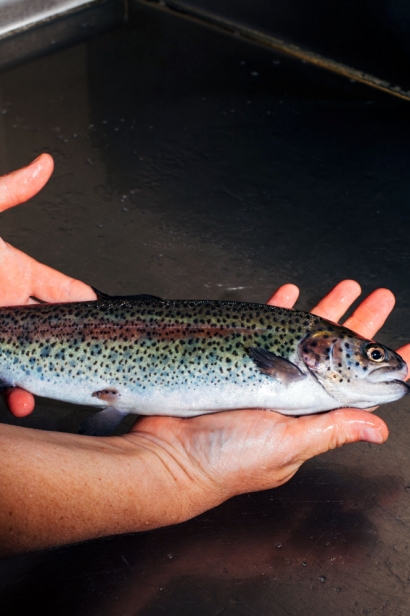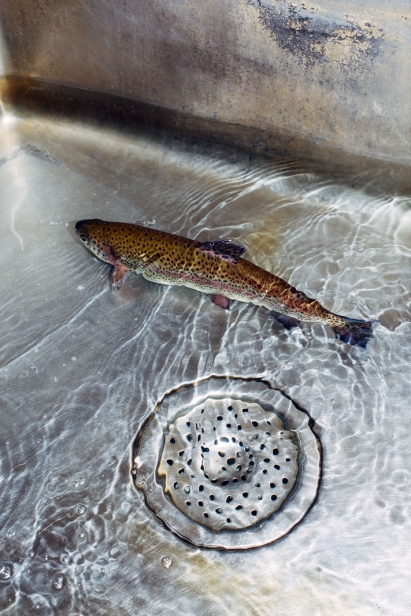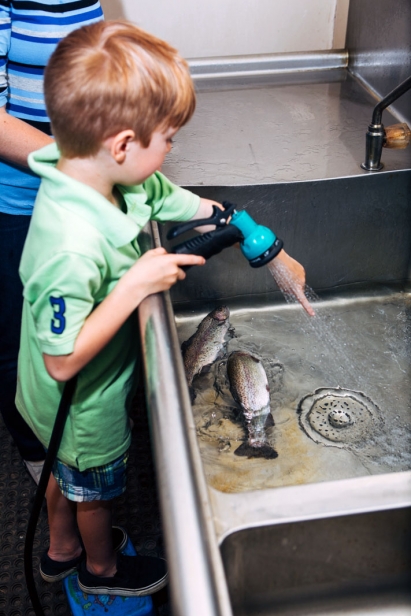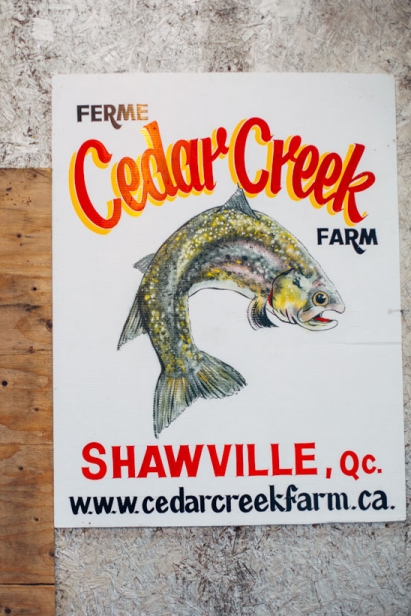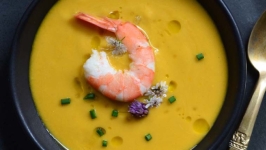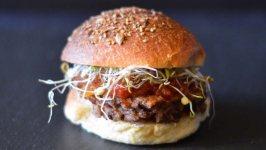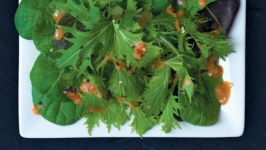Farming Trout
There’s little evidence to suggest that close to 200,000 fish live in farm country tucked away down a rural sideroad about a 10-minute drive north of Shawville, Québec. There are no large ponds, nor people standing around with fishing rods; only a very fast running stream, Cedar Creek in full spring spate, to suggest that this might be a good place to raise fish, rather than more conventional agricultural produce.
Good clean water is at the centre of any successful fish farm. And at Cedar Creek, there’s plenty of it. Ten huge tanks, each as large as a small swimming pool and containing more than 4,000 gallons of water, hold tens of thousands of wiggling fish. Sparkling fresh water from two on-property springs gushes into each tank.
Each day, Laura Palmer makes sure these tanks and the water the fish live in remains pure and clean. There are signs all over the place that read, “No Hands,” to discourage anyone from dangling less-than-clean fingers into the tanks. She flushes each tank daily, replacing the majority of the water, sweeping away any leftover fish food and gunky build-up. If she has to, she’ll even don a pair of hip waders and leap into the tank among the fish to scrub where needed. The waste water is filtered through two sediment ponds and the particles settle out. “We pump this waste out and spread it on the hay fields twice a year,” Laura explains.
Cedar Creek Farm is the home of Laura Palmer and her husband, Cory Thomas, and their children Ethan, 7; Owen, 5; and Emma, 3. They know fish.
“The children love to help out in the barn,” Laura says, as Ethan sucks up dead fry (tiny fish) in one of the nursery tanks using a turkey baster. "And Cory helps out with the mechanical and electrical.”
Cory, who works off-site as an electrician, oversees the huge onsite generator — a lifeline for the fish in the case of a power outage. With no oxygen in still water, the fish would start to die in about 10 minutes.
Laura grew up on the property next door to Cedar Creek, a beef farm where her parents still live. She studied fish biology at the University of Guelph, graduating in 2000 and then went on to get practical experience at a tilapia farm near Johnstown, Ont. In 2002, she married Cory, originally from nearby Quyon, and when Cedar Creek Farm came up for sale in 2003, the newlyweds bought the 250-acre property. They also now farm two acres of Highbush blueberries and lease the remainder of the land to a local farmer.
Previously a tobacco farm, subsequently a fish farm, the previous owner had given up farming trout back in the late 1990s, but the infrastructure — the tanks and water system — remained in place, although it’s not ideal, explains Laura, as the water has to be pumped a long way. It took a couple of years for the couple to get all the relevant permits in place, but, by 2005, they were up and running and now have plans for expansion.
Today, a full 13 years later, Laura brings in spawn three times a year from a producer near Quebec City. The eggs — bright orange with a small dark eye and about the size of a pea — come in cardboard boxes packed on ice. One medium-sized box holds about 60,000 eggs.
Two-thirds of her production is speckled trout and one-third rainbow. The rainbows are Triploids, “which means the fish have three genes so the fish are XXX or XXY genes, making them all female and sterile,” Laura explains. “They will grow faster and put no energy into egg production.” The females are also less aggressive.
Raising fish is a slow process. From the moment the eggs hatch and resemble long, dark splinters of wood floating in the water, to the moment when they measure about six inches long or the size of a healthy sardine, a year has passed. After that, it takes another year for them to double in size. Generally, Laura will keep fish until they weigh approximately three pounds, but in 2017, one of the largest fish that she has ever produced was close to five and a half pounds.
The fish live in tanks by size and species. Rainbows tend to be jumpers, so their tanks are covered with nets so that they don’t leap out. The speckled trout are a bit more finicky and fussy.
Both types are hungry carnivores so will attack one another and eat any tank mates that don’t make it. Generally, there are about 7,000 fish to a tank when they are six-inches long, dropping down to about 2,500 when they’re 10 to 12 inches. But no matter their size, when Laura throws handfuls of pelleted fish food into the tanks, the water boils with leaping fish, their silver scales glistening in the low light of the barn where they live.
The majority of Laura’s customers come to buy live fish, mostly speckled trout, to stock lakes for fishing. They’ll buy fish by the hundreds, in several sizes. However, most of the rainbow trout are sold in Quebec to restaurants such as Le Rustiek in Hull and Café 349 in Shawville and through stores such as Le Marché de l’Outaouais and at Juniper Farm in Wakefield.
Surprisingly, the Giant Tiger store in nearby Shawville is one of her biggest clients. Local residents know the secret to great fresh fish is Cedar Creek Farm trout. But Laura cannot sell her fish into Ontario due to provincial trade restrictions on fish sales; and with a new Canadian Free Trade Agreement recently unveiled by the federal and provincial governments, fish trade isn’t going to change any time soon.
Laura and her mother process between 100 and 200 fish weekly in a squeaky-clean stainless steel workroom attached to the fish barn. They prepare vacuum packed trout fillets, whole fish with heads removed, smoked fillets and smoked trout pâté.
Though Laura is a creative cook her children like their trout served simply — battered, fried and served with French fries. Her husband, Cory, doesn’t like fish at all.
Cedar Creek Farm
233 - 12th Concession, Shawville, Que.
cedarcreekfarm.ca, 819.647.2428


